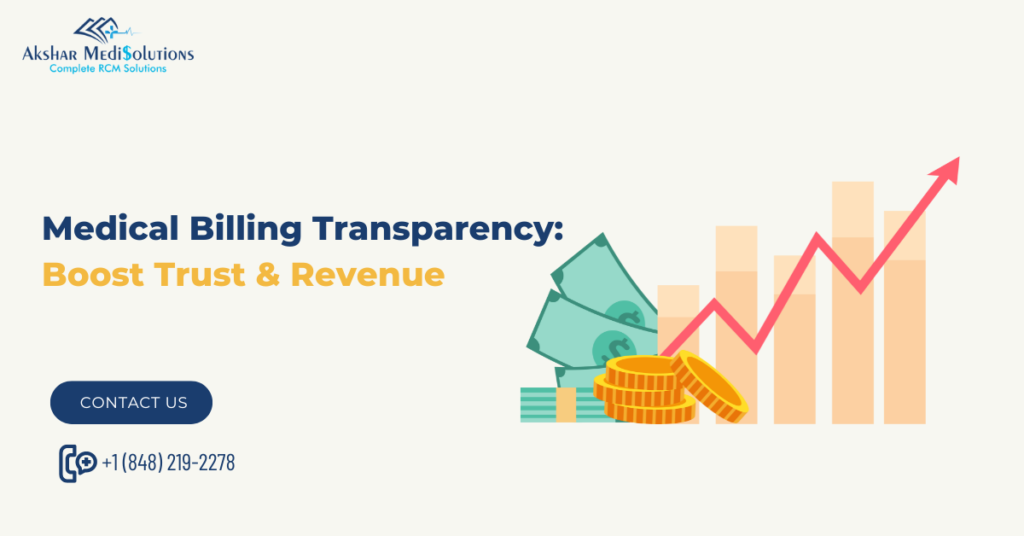In today’s healthcare landscape, transparency in medical billing is not just a regulatory requirement but also a cornerstone of patient trust and financial health for medical practices. Patients are increasingly involved in their healthcare decisions, often comparing costs and seeking clarity on charges. Meanwhile, medical practices face the challenge of navigating complex billing processes while maintaining compliance with evolving regulations. This blog explores the importance of transparent reporting in medical practices, its impact on trust and revenue, and best practices for achieving effective transparency.
Why is Transparent Reporting Essential for Medical Practices?
Transparent reporting in medical billing refers to the clear disclosure of healthcare costs, fees, and charges to patients, insurers, and other stakeholders. This transparency is crucial for several reasons:
- Building Patient Trust: Transparent billing practices instill confidence in patients by providing clear explanations of costs upfront. Patients appreciate knowing what to expect financially, which reduces anxiety and builds trust in the healthcare provider.
- Enhancing Patient Satisfaction: When patients understand their medical bills and are not surprised by unexpected charges, their overall satisfaction with the healthcare experience improves. This leads to better patient retention and positive word-of-mouth referrals.
- Compliance with Regulatory Requirements: Healthcare regulations, such as those set forth by the Centers for Medicare & Medicaid Services (CMS) and other governing bodies, mandate transparency in billing practices. Compliance helps avoid penalties and legal issues for medical practices.
- Improving Revenue Cycle Management: Transparent reporting facilitates smoother revenue cycle management by reducing billing errors, denials, and delays in payments. It streamlines the billing process, leading to faster reimbursements and improved cash flow for medical practices.
- Ethical Responsibility: Healthcare providers have an ethical obligation to provide patients with accurate and understandable information about healthcare costs. Transparent billing practices uphold this ethical standard and promote fairness in healthcare financial transactions.
You can also read: How Revenue Cycle Management Can Help Medical Billing Business?
Best Practices for Transparent Reporting
Achieving transparency in medical billing requires proactive strategies and adherence to best practices. Here are key considerations for implementing transparent reporting in medical practices:
1. Clear Communication with Patients
- Detailed Cost Estimates: Provide patients with accurate estimates of costs before procedures or treatments. Utilize tools and software that can calculate estimated out-of-pocket expenses based on insurance coverage and deductible status.
- Explanations of Charges: Clearly explain each charge on the medical bill, including the purpose of the charge, the service provided, and any associated fees or costs.
- Financial Counseling: Offer financial counseling services to help patients understand their insurance coverage, deductible amounts, co-pays, and potential financial assistance options.
2. Utilization of Standardized Coding and Documentation
- Use of Standard Codes: Ensure that all medical billing codes (ICD-10, CPT, HCPCS) are accurately documented and compliant with current regulatory standards.
- Consistent Documentation: Maintain consistent and thorough documentation of patient encounters, procedures performed, diagnoses, and treatment plans to support billing accuracy.
3. Technology Integration for Transparency
- Electronic Health Records (EHR) and Practice Management Systems: Implement EHR and practice management systems that integrate billing functionalities. These systems streamline billing processes and enable real-time access to patient billing information.
- Patient Portals: Offer secure online patient portals where patients can access their medical records, billing statements, and payment history. Provide clear instructions on how to navigate and interpret billing information.
4. Training and Education for Staff
- Staff Training: Train administrative staff on the importance of transparent billing practices, regulatory requirements, and effective communication strategies with patients regarding billing and financial matters.
- Continuing Education: Stay updated on changes in healthcare regulations and billing guidelines through ongoing staff education and professional development programs.
5. Regular Audits and Quality Assurance
- Billing Audits: Conduct regular audits of medical billing practices to identify errors, discrepancies, or areas for improvement. Address any issues promptly to maintain billing accuracy and compliance.
- Quality Assurance Measures: Implement quality assurance measures to monitor the effectiveness of transparent reporting practices and patient satisfaction with billing processes.

